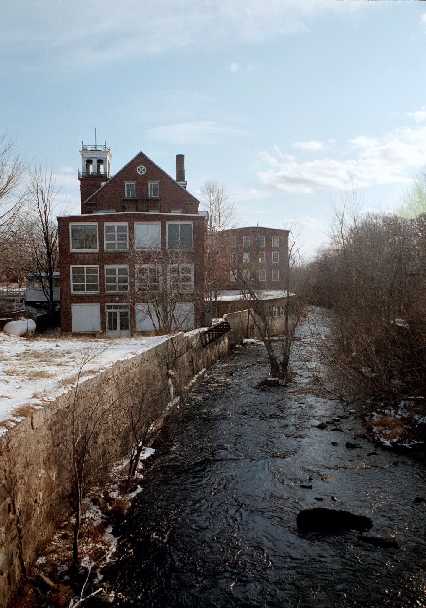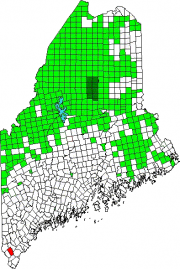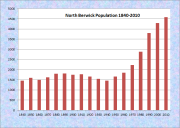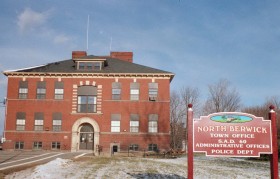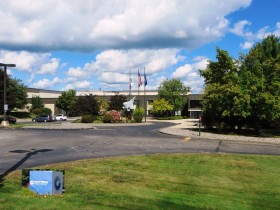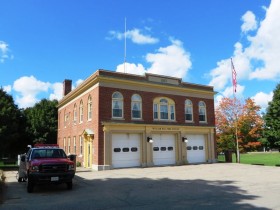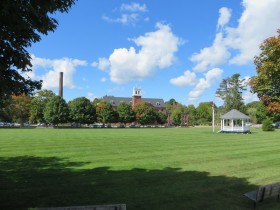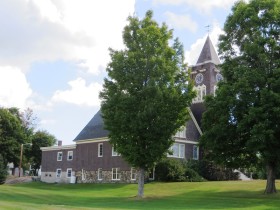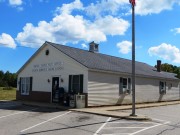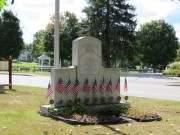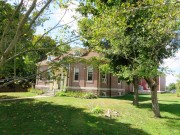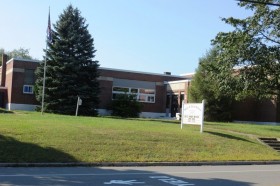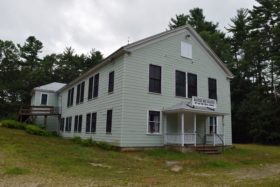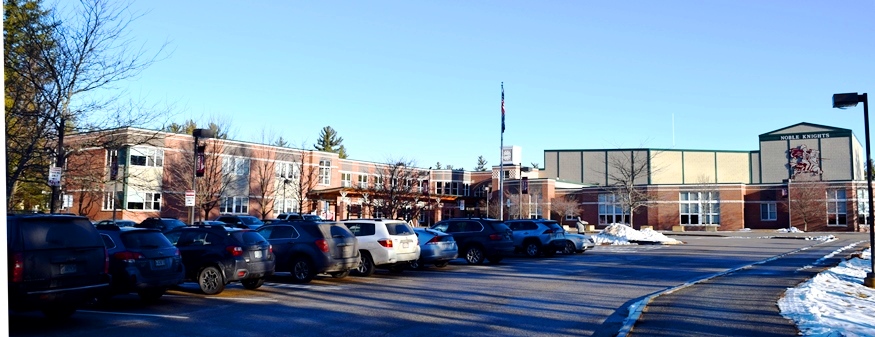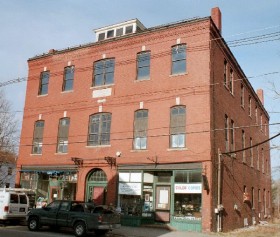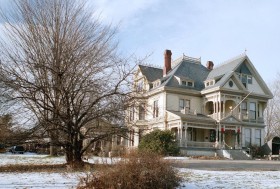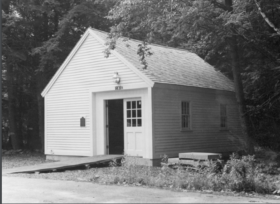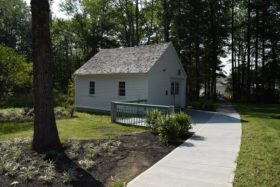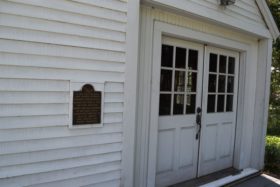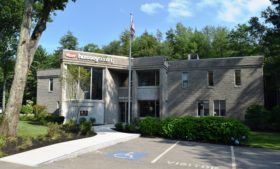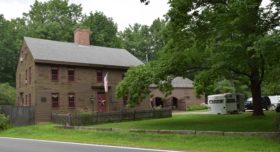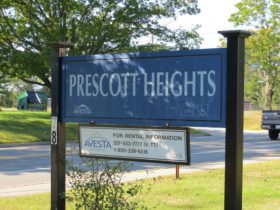| Year | Population |
|---|---|
| 1970 | 2,224 |
| 1980 | 2,878 |
| 1990 | 3,793 |
| 2000 | 4,293 |
| 2010 | 4,576 |
| Geographic Data | |
|---|---|
| N. Latitude | 43:20:38 |
| W. Longitude | 70:46:22 |
| Maine House | Dists 5,6 |
| Maine Senate | District 34 |
| Congress | District 1 |
| Area sq. mi. | (total) 38.5 |
| Area sq. mi. | (land) 38.3 |
| Population/sq.mi | (land) 119.5 |
County: York
Total=land+water; Land=land only |
|
[north BER-wik] is a town in York County, incorporated on March 22, 1831 from a portion of the town of Berwick, later annexing more land from that town in 1875.
Settlers arrived in about 1630. Since the area was inhabited by Native Americans, conflict between them and the Europeans was frequent. Its early history is that of Berwick, incorporated in 1713.
The town’s population in 1880 was 1,801; that total has more than doubled and continues to grow.
The North Berwick Woolen Mill is a historic landmark on the banks of the Great Works River that passes through the main village.
Here is a description of the mill and other economic engines of the late 19th century from the Gazetteer of Maine:
The North Berwick Woolen Mill have a fine brick mill on the Great Works River, at the village. It is 120 feet long and three stories in height, and has an engine of sufficient power to carry the mill in case of drought. Forty looms, six sets of cards, and thirteen spinning jacks are operated, which turn out daily 1,500 yards of flannel, beside blankets, and employ about 80 hands. The capital is $100,000.
At the foot of Bonny Bigg Pond is a saw, grist, shingle and clapboard mill. On the Negutaqueit are the Hussey Agricultural Works, manufacturing farm implements. Other factories are a carding and yarn mill, a box and shook mill, several saw mills, stove polish factory, and many other lesser industries, including an extensive brick-yard.
Farmer William Hussey designed a cast iron plow in 1835. The resulting Hussey Plow Company expanded to manufacturing other farm equipment and tools. A history of innovation has led it to become a leader in producing seating solutions for stadiums and auditoriums. (See more about the Hussey company below.)
Defense contractor United Technologies, Pratt & Whitney has a major facility in the town.
This rapidly growing community is within an easy commute to Sanford, the Kennebunks, and, through South Berwick, to Kittery and Portsmouth.
Form of Government: Town Meeting-Select Board-Manager.
Additional resources
Buffum, Samuel. Historical Sketch of North Berwick. Maine. 1931. [University of Maine, Raymond H. Fogler Library, Special Collections; Maine State Library]
Cloyd, Royal. The Parish of Unity and the Men of Dunbar. North Berwick, Me. North Berwick Historical Society, 1996. [University of Maine, Raymond H. Fogler Library, Special Collections]
Cloyd, Royal. Something in the Air. North Berwick, Me. North Berwick Historical Society. 1997. [University of Maine, Raymond H. Fogler Library, Special Collections]
Doughty Falls: The History of the Town of North Berwick, Maine, 1831-2006. Portsmouth, N.H. Published for the North Berwick Historic Committee by Peter E. Randall Publisher. 2006.
A Pictorial History of North Berwick, Maine. Compiled by the North Berwick Bicentennial Committee. 1976. [University of Maine, Raymond H. Fogler Library, Special Collections; Maine State Library]
*Maine. Historic Preservation Commission. Augusta, Me. Text and photos from National Register of Historic Places: http://pdfhost.focus.nps.gov/docs/nrhp/text/xxxxxxxx.PDF and http://pdfhost.focus.nps.gov/docs/nrhp/photos/xxxxxxxx.PDF
Maine. Notary Public (North Berwick). Peletiah Hussey, Notary Public Docket, ca. 1861 Jan. 2-1875 March 27. (Cataloger Note: This docket records the Notary Public documents recorded by Peletiah Hussey. These civil records deal with debt cases.) [Maine State Archives]
National Register of Historic Places – Listings
Hobbs, Thomas, Jr., House
[Wells Street] Also known as The Hostelry and dating from 1763, the house is a fine and well-preserved example of local domestic architecture of the later colonial period. The 2-1/2-story house is of frame (post-and-beam) construction, with gable roof, central brick chimney, clapboard siding, and fieldstone foundation.
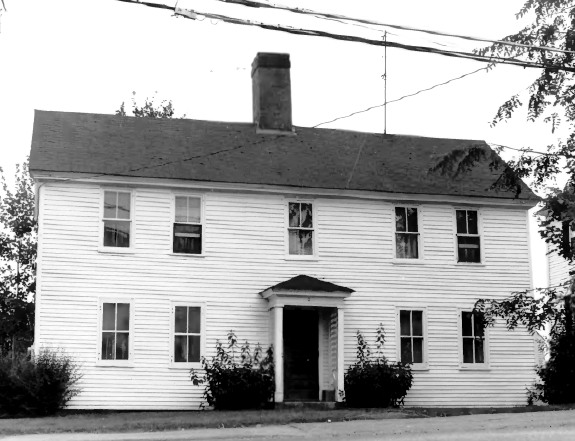
Thomas Hobbs, Jr. House (1982)
The front, which faces northwest with a central entrance, reflecting the center-hall plan typical of the period. Typical of this early period, the building is only one room deep. Extending from the rear (southeast side) of the house is a low, one-story ell that contains a window and a simple doorway facing northeast.
Hurd, Mary R., House
[Elm Street] In many small towns, one house stands out in size and elegance from other residences. Rarely is it a house built by a woman. This remarkable person, industrialist and local benefactor, was born in 1832, daughter of William Hill, one of the large Quaker population of the area and founder of the North Berwick woolen mill.
She was twice married, in 1870 to William Hobbs, whose two daughters by a previous marriage she brought up as her own, and in 1894, ten years after his death, to David A. Kurd who lived until 1931. At the time of her second marriage she built the great Queen Anne house on a hill at the main intersection overlooking the mill. Her father died in 1873, as his only heir she took over the administration of the mill. She continued for nearly sixty years until shortly before her death at age 94 in 1933. Even in her last years during the early period of the Depression she kept the mill going, three shifts a day, , often paying much of the payroll out of her own pocket.
In 1928 she built and gave to the town a complete modern fire station, including a large meeting hall on the second floor. She purchased at least one new fire truck. She was a founder and principal incorporator of the North Berwick Bank and, with her husband, built and endowed the D. A. Kurd Library. Her private charitable acts were legion and her outgoing friendly ways made her beloved by the town. The house that she built is the most outstanding example of its style in southern Maine and no where in the state does a more impressive wooden Queen Anne-Eastlake house exist.*
Hussey Plow Company Building
[Dyer Street] This humble structure is a symbol of the Hussey Manufacturing Company. From modest origins in 1835, this firm, under the leadership of successive generations of one family, grew constantly adapting its products to changes in demand. William Hussey (1800-1870) of North Berwick was a descendant of Christopher Hussey who came to Lynn, Massachusetts from England in 1632. A simple Quaker farmer, William was introduced at age 35 to the cast iron plow recently invented by Jethro Wood of New York. By redesigning and lengthening the mould board, Hussey developed a plow that became locally popular. The foundry work for the early Hussey plows was done in New Market, N.H. while wooden components were fabricated and the plows assembled in North Berwick. William’s son, Timothy B. Hussey, established the T.B. Hussey Plow Co. which carried on all manufacturing operations in North Berwick. It was he who set the standards and established the model that carried the company through more than one crisis. Over the remainder of the century, the Company expanded its line of products to include a newly patented stone boat, iron pipe hangers for sprinkler systems in the newly emerging textile mills, cast iron sled shoes, sewer grates and manhole covers, and a cord wood sawing machine.
Surviving a disastrous fire in 1895, the new century saw the company, now under Timothy’s three sons, producing steel ladders and fire escapes. In 1912 the plant was moved to a location beside the railroad tracks. Philip William Hussey, Sr., Timothy’s grandson, became active in the company in the early 1900s.
The plant was enlarged and production of water sports equipment (floats, diving boards, etc. ) became an important manufacturing sideline. The 1930’s saw the Beginning of bleacher seat construction, both portable and rigid and in the 1950’s indoor roll-out gym seats. * [Frank A. Beard B&W photo] Hussey Seating Company was still thriving in 2018, the year of the color photos.
Morrell House
[North of North Berwick on Bauneg Beg Pond Road] The 1763 Morrell House was built by Winthrop Morrell, a descendant of one of the first settlers in North Berwick. The house is a fine example of the architectural style of the late colonial period. The house has been restored. John Morrell of Kittery received a lot from his father-in-law in what was called Kittery Common, part of what is now North Berwick. The Morrell family was one of the first settlers in the area. John Morrell Jr. built a log-house on Kittery Common in 1640. Later he built a larger house, now known as the Morrell-Sherbourne house. John Jr. had two sons, Peter and Jedediah. Peter owned all the water power and adjacent lands on both sides of the Great Works River. He built a grist mill on the-river and later tried, unsuccessfully, to run an iron works. This was replaced by a wool carding mill, which led to the establishment the wool industry in the town.
Jedediah was a farmer and a blacksmith. His knowledge of medicine won him the reputiation as the first town doctor. He built a saw mill on Bauneg Beg lake, later burned by the Indians. It was replaced, however, and operated until 1925. At his death Jedediah left his son Winthrop the farm, while another son of the homestead built by John Jr. In 1763 planned and built his own house. The original barn was destroyed, so another 18h century structure from a neighboring farm was moved onto the site. Winthrop tried his hand in the sawmill business, the Abenaki Indians burned all three mills that he built.
Throughout the early days of the settlement Indian relations were uneasy. The Morrells were a peaceful family of the Quaker faith. This helped the relationship, for when the Indians learned the family were Quakers, they made peace. A young cousin of Winthrop’s, a sickly girl, was literally scared to death by an Indian. The Indian confessed and the Morrell family believed the story, avoiding war. “No scalp was ever cut from a human head in Kittery Corner”, the town history boasts. Built by a family descended from the earliest settlers in the area, the Old Morrell House is a worthy and beautifully restored example of mid-18th century rural architecture in southwestern Maine.* [Frank A. Beard photos]
North Berwick Woolen Mill
 [Canal Street] The Woolen Mill at North Berwick is the only major mill structure in the Berwick area, and is one of the more stylistically eclectic of Maine’s numerous rural Woolen mills. Although built in 1862, the mill incorporates Italianate, Greek Revival, Gothic Revival, and even some neo-Colonial stylistic features.
[Canal Street] The Woolen Mill at North Berwick is the only major mill structure in the Berwick area, and is one of the more stylistically eclectic of Maine’s numerous rural Woolen mills. Although built in 1862, the mill incorporates Italianate, Greek Revival, Gothic Revival, and even some neo-Colonial stylistic features.
A woolen mill was first built on the site in 1834, and operated until about 1862, when it was destroyed by fire. It had been the first in the nation to produce machine-made blankets.
The building of the current mill luckily coincided with a contract to produce blankets for the Union Army, which markedly increased the scale of operations. The mill operated until the late 1950s.*
Prescott, J. L., House
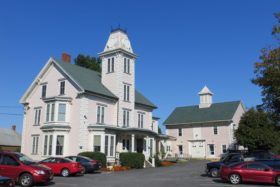 [High Street (See photo at top)] The Prescott House is the largest, most finely executed and most stylish house of its period in southern York County. It is interesting to find it in a small rural community that boasts only one other notable house: the Queen Anne Mary Hurd House.
[High Street (See photo at top)] The Prescott House is the largest, most finely executed and most stylish house of its period in southern York County. It is interesting to find it in a small rural community that boasts only one other notable house: the Queen Anne Mary Hurd House.
Prescott House was built by J. L. Prescott, owner and president of the Prescott Stove Polish Company, then located in North Berwick. He was very involved in Maine politics and entertained both Governor Joshua L. Chamberlain and his successor, Governor Sidney Perham, at the house. He remained in the house for only a relatively short time, however, since he relocated the stove polish plant to New Jersey in the early 1880s.*


